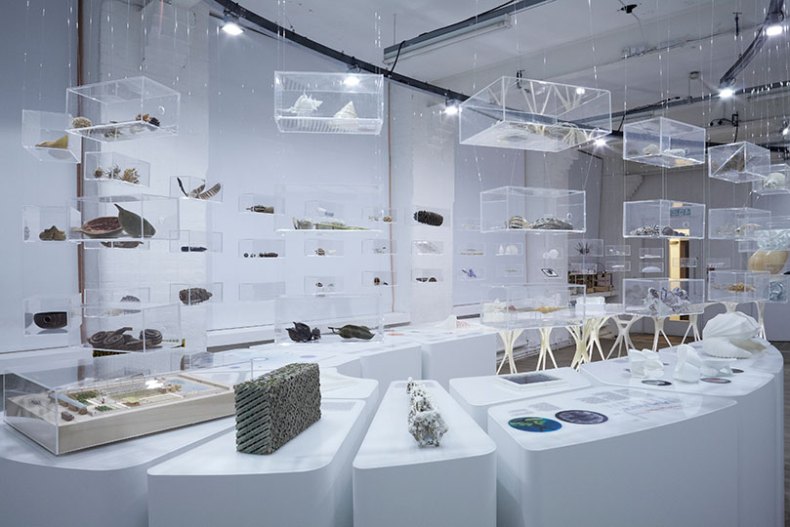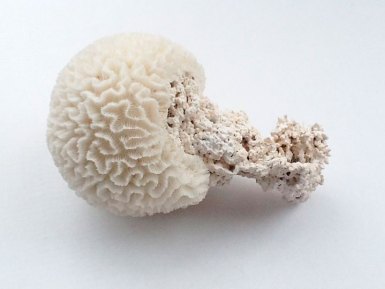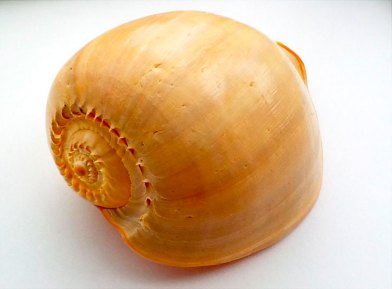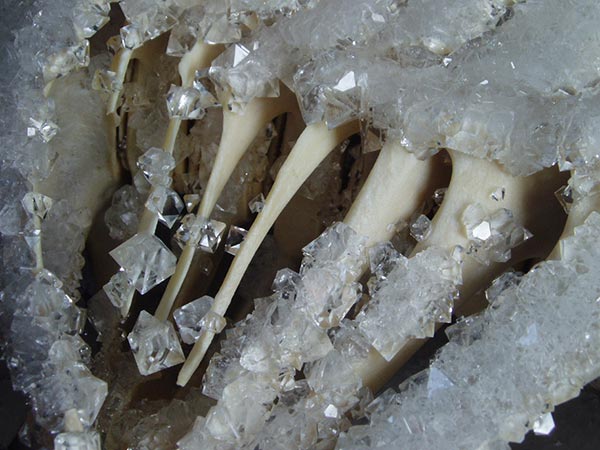The contemporary art world may not be concerned about the environmental impact of their practices in quite the same way as some other industries, but issues surrounding sustainability are not out of mind. The Architecture Foundation is currently staging an exhibition, ‘Exploration Architecture: Designing with Nature’, which focuses on architecture and design using biomimicry, with a small showcase of 3D-printed architectural prototypes.
One such prototype is the BioRock Pavilion – a roofed structure with stepped seating that could be used as a performance space – that would be grown in seawater using electro-deposition. In theory, when fully grown it could be floated to surface level and towed to an urban locale with a waterfront such as London’s South Bank – and, of course, it would always be portable.

‘Exploration Architecture: Designing with Nature’ at the Architecture Foundation. Courtesy Daniel Hewitt
Another concept is The Mountain Data Centre. Mimicking the behavioural habits of ground-burrowing creatures, it is a building (of sorts) that would allow computer servers to be cooled for free with absolute security, inside a Norwegian mountain where the temperature is 5 degrees Celsius all year round.
These structures may be hypothetical, but the organisms and natural objects that have inspired them are exhibited in plain view. Sea urchins, cuttlefish bones, radiolaria, pine cones, corals and conches all have a place – in fact, as the Foundation points out, there’s a 3.8 billion year research and development project here that contemporary architects are benefiting from.

Coral, courtesy Exploration Architecture

Melonshell, courtesy Exploration Architecture
Are visual artists making similar strides? A couple of years ago, Arts Council England (ACE) launched an initiative that ‘introduced environmental policy and action plan requirements for more than 700 of [their] revenue funded organisations.’ It’s hardly glamorous, but it has made ACE one of the leaders in sustainability and art. Its position is that arts and cultural sectors have an important role to play in leading and inspiring broader societal change.
‘Broadly speaking, we want arts and cultural organisations to engage with sustainability in such a way that they start the process of transforming themselves into a low-carbon, sustainable and resilient sector’, says Ian Rimington of ACE.
Among ACE’s project clients is Invisible Dust, an organisation that produces art that responds to issues of sustainability, collaborating with various artists as well as institutions such as the National Maritime Museum. Meanwhile Cape Farewell, based in London’s Science Museum, employs a more practical approach – visual artists Ackroyd & Harvey were sent on a series of expeditions by the non-profit, resulting in Stranded (2003), a six metre minke whale skeleton encrusted with a chemical growth of alum crystals.

Stranded (detail; 2006) Ackroyd & Harvey. Image courtesy the artists
That artists respond to the topic of sustainability in their work is one thing – making the actual processes sustainable as a matter of course is another. Artists using purely recyclable materials or making biodegradable sculptures remain in a ‘green’ minority. As architectural practices become increasingly ecologically-minded and begin to implement their research, visual artists are still playing catch-up.
‘Exploration Architecture: Designing with Nature’ is at the Architecture Foundation, London, until 11 April.
Related Articles:
Intelligent Design: Beautiful Science at the British Library (Peter Crack)
A Collection of Ideas: Five Innovations at MoMA (Luke Baker)
Printing Press: 3D printing (Camilla Apcar)

Art, Architecture and Sustainability
'Exploration Architecture: Designing with Nature' at the Architecture Foundation. Courtesy Daniel Hewitt
Share
The contemporary art world may not be concerned about the environmental impact of their practices in quite the same way as some other industries, but issues surrounding sustainability are not out of mind. The Architecture Foundation is currently staging an exhibition, ‘Exploration Architecture: Designing with Nature’, which focuses on architecture and design using biomimicry, with a small showcase of 3D-printed architectural prototypes.
One such prototype is the BioRock Pavilion – a roofed structure with stepped seating that could be used as a performance space – that would be grown in seawater using electro-deposition. In theory, when fully grown it could be floated to surface level and towed to an urban locale with a waterfront such as London’s South Bank – and, of course, it would always be portable.
‘Exploration Architecture: Designing with Nature’ at the Architecture Foundation. Courtesy Daniel Hewitt
Another concept is The Mountain Data Centre. Mimicking the behavioural habits of ground-burrowing creatures, it is a building (of sorts) that would allow computer servers to be cooled for free with absolute security, inside a Norwegian mountain where the temperature is 5 degrees Celsius all year round.
These structures may be hypothetical, but the organisms and natural objects that have inspired them are exhibited in plain view. Sea urchins, cuttlefish bones, radiolaria, pine cones, corals and conches all have a place – in fact, as the Foundation points out, there’s a 3.8 billion year research and development project here that contemporary architects are benefiting from.
Are visual artists making similar strides? A couple of years ago, Arts Council England (ACE) launched an initiative that ‘introduced environmental policy and action plan requirements for more than 700 of [their] revenue funded organisations.’ It’s hardly glamorous, but it has made ACE one of the leaders in sustainability and art. Its position is that arts and cultural sectors have an important role to play in leading and inspiring broader societal change.
‘Broadly speaking, we want arts and cultural organisations to engage with sustainability in such a way that they start the process of transforming themselves into a low-carbon, sustainable and resilient sector’, says Ian Rimington of ACE.
Among ACE’s project clients is Invisible Dust, an organisation that produces art that responds to issues of sustainability, collaborating with various artists as well as institutions such as the National Maritime Museum. Meanwhile Cape Farewell, based in London’s Science Museum, employs a more practical approach – visual artists Ackroyd & Harvey were sent on a series of expeditions by the non-profit, resulting in Stranded (2003), a six metre minke whale skeleton encrusted with a chemical growth of alum crystals.
Stranded (detail; 2006) Ackroyd & Harvey. Image courtesy the artists
That artists respond to the topic of sustainability in their work is one thing – making the actual processes sustainable as a matter of course is another. Artists using purely recyclable materials or making biodegradable sculptures remain in a ‘green’ minority. As architectural practices become increasingly ecologically-minded and begin to implement their research, visual artists are still playing catch-up.
‘Exploration Architecture: Designing with Nature’ is at the Architecture Foundation, London, until 11 April.
Related Articles:
Intelligent Design: Beautiful Science at the British Library (Peter Crack)
A Collection of Ideas: Five Innovations at MoMA (Luke Baker)
Printing Press: 3D printing (Camilla Apcar)
Unlimited access from just $16 every 3 months
Subscribe to get unlimited and exclusive access to the top art stories, interviews and exhibition reviews.
Share
Recommended for you
Mothering Sunday
A selection of images of some of the best mothers in art
Designs of the Year 2014
Highlights from the upcoming ‘Designs of the Year 2014’ exhibition at the Design Museum, London
Grayson Perry wins 25th Critics’ Circle Annual Award
Grayson Perry is the first visual artist to receive the honour. He must be getting used to making that claim.